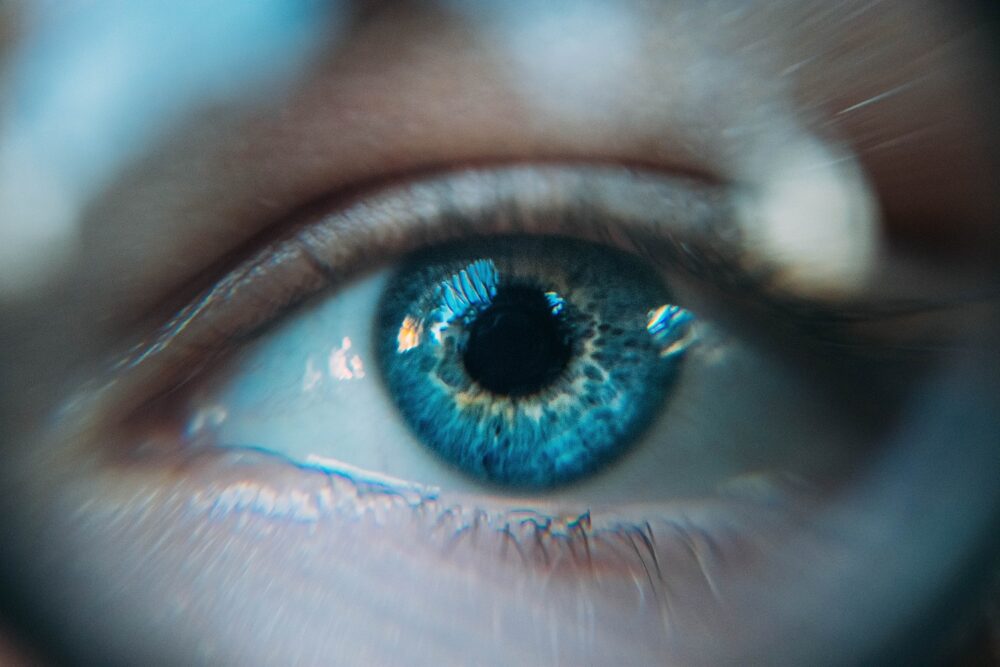The number of internet searches for eye strain advice has risen more than 150% in the past 12 months1, indicating that Computer Vision Syndrome (CVS), as it is also known, is fast becoming one of the UK’s most prolific eye conditions.
So as we focus on eye health in the UK for National Eye Health Week 2021, an awareness campaign which aims to inspire and educate people on the importance of eye health and why they should go for regular sight tests, leading vision specialists Essilor.co.uk offers this advice for combatting eye strain and the other most common eye issues in 2021.
Leading eye expert Dr Andy Hepworth from Essilor.co.uk says: “With new statistics revealing that UK adults spend on average half our day in front of a screen (an average of 4,542 hours each year)2, it is not surprising that the nation has turned to Google for information and advice on how to combat eye issues associated with screen time; it’s worth remembering that our eyes weren’t designed for screens.
“It is also well documented that the last 18 months has taken its toll on our eyes – from an increase in screen time and millions of eye tests missed.
“Our vision is at risk of suffering some long-term consequences if our eyes are not given the regular check-ups that they need. If you have noticed a change in your vision or eye health you may be experiencing one of the following common eye conditions.
“Here is what to look out for and ways you can alleviate any discomfort:
Eye strain or Computer Vision Syndrome (CVS)
Eye strain is a feeling of fatigue or soreness in your eyes which occurs from concentrating at a fixed object for a long period of time without breaks. This could be a computer screen, Tablet or mobile phone. Other causes of eye strain include reading under a dim light, incorrect glasses or contact lens prescriptions and even tiredness and stress. Whilst eye strain is uncomfortable and irritating at the time, there are no long-term health consequences.
But if you are experiencing eye strain, try the following:
- Be strict about taking regular screen breaks throughout the day. Use the 20-20-20 rule. Every 20 minutes look at something 20 feet away for 20 seconds, it’s easy to look at your phone for 20 minutes straight so try this throughout the day to give your eyes a rest.
- Try some eye yoga. This can be done anywhere, anytime. Look to the left, hold the position, repeat looking right. Look up, hold the position, repeat looking down. Repeat four times, closing your eyes and relaxing in between.
- Digital detox – you may need to use a screen for work but you can reduce your screen time significantly if you take a break from your devices in the evening. Try and give yourself and your eye some down time with a post-work digital detox or over the weekend
Dry Eye Syndrome
Dry Eye Syndrome is often seen as a symptom of eye strain but in fact it is an issue it its own right – and around one in four people in the UK (around 13 million adults) currently suffer from it. Dry Eye can be more noticeable through excessive screen time but also prolonged exposure to air conditioning or heating, and wearing contact lenses for long periods. It can also be down to hormone imbalances. Women going through the peri-menopause and menopause may also notice their eyes becoming dryer as it can be linked to hormonal changes due to levels of oestrogen decreasing.
Symptoms are varied, but most people experience a scratchy, gritty feeling that they just can’t shift, redness and puffiness, fatigued eyes that don’t want to open, even when they’ve had enough sleep, blurred vision, sensitivity to bright light and sometimes excessive watering.
Although it is uncomfortable and irritating, short term bouts of Dry Eye is not a serious condition. Dry Eye can be managed with drops that lubricate the eyes in a natural way, giving short relief from the uncomfortable symptoms.
Eye Twitching
Eye lid twitching or spasms are very common and usually occur when you are tired, stressed, dehydrated, have drunk too much caffeine or if your eyes are irritated. An eye twitch is when your eyelid feels like it is quivering or being tugged. Sometimes this sensation can come and go very quickly, at other times it could last for several days.
Eye twitching is another lifestyle-related eye issue and twitches don’t usually indicate any underlying eye health condition, although if you are concerned about eyelid spasms and if your symptoms become chronic then it is advisable to contact your optician or GP.
To combat eyelid twitching you could try applying a warm compress to the eye, making sure you are getting enough sleep and are properly hydrated, monitoring your alcohol and caffeine intake and trying some relaxation techniques.
Floaters
Small black dots in your line of vision are known as floaters – these are common and often go away on their own. However, if you notice an increase in floaters, especially accompanied with flashing lights, this could indicate a more serious problem and you should contact your optician or GP immediately.
Floaters are tiny pieces of debris in the eye fluid that is often associated with ageing. They should settle on their own and not cause ongoing issues, however you may require treatment if they are impacting your vision significantly.
Age-related eye issues (Macular Degeneration and Glaucoma)
Whilst many eye issues are common and lifestyle-related, there are a number of more serious age-related eye issues that shouldn’t be ignored. These include cataracts, glaucoma and macular degeneration. Often these conditions can cause vision to deteriorate over time and you may not be aware that you are experiencing symptoms. With this is mind it is crucial to attend an eye examination at least every two years so your optician has a full and up-to-date record of your eye health and can spot any more serious issues at an early stage.
Cataracts
Cataracts are what happen when the lens within the eye gradually becomes cloudy, loses transparency and impairs vision. Cataracts develop gradually over the years and sometimes they go unnoticed as the vision deteriorates so slowly. While cataracts are not painful, they will affect your eyes in several ways – sometimes one eye will be worse than the other, but usually both are affected.
Signs of cataracts include blurry or cloudy vision, faded colours, glare or a ‘halo’ effect when looking at lights, double vision, frequent changes in your glasses/contact lenses prescription and trouble seeing at night.
The tests used to diagnose cataracts are fairly standard and the type of tests you would have at a regular check-up. Therefore, as long as you make and attend regular eye tests, the development of cataracts should be picked up by your optometrist.
Essilor.co.uk is also using National Eye Health Week to debunk some of the most popular eye myths – how many of these were you aware of – Dr Hepworth shares his advice:
TRUE OR FALSE? “Watching too much TV or sitting too close to the screen ruins your eyesight”
Staring at a TV screen a few meters away from you does not create short-sightedness, long-sightedness or astigmatism. However, digital screens like phone or tablet screens are viewed at a close distance, e.g. within arm’s reach, and are pixelated – with the pixels constantly refreshing – which means both the above aspects mean your eyes are having to work much harder to view which often leads to eye strain.
A good rule to obey if you must look at your screen for sustained periods would be to follow the 20-20-20 rule (take a break from screens every 20 minutes, focus on something 20 feet away for 20 seconds) or by using special lenses designed reduce eye strain from screens. Another great idea for any younger person is to spend more time outdoors, there is ever more evidence that suggests this can reduce the onset of short sightedness.
TRUE OR FALSE? “Eating carrots improves your vision”
Vitamins A, C and E can help to maintain healthy eyes and vision. Carrots are rich in vitamin A so, while eating them as part of a balanced diet that promotes eye health can help to maintain good sight, there is no solid evidence that specifically links eating lots of carrots to better eye health. Other foods such as salmon and tuna, and dark, leafy greens (such as spinach and kale) are also great foods to promote and maintain healthy sight.
TRUE OR FALSE? “Reading in the dark will damage your eyes”
While reading in low light may cause eye fatigue and, possibly, a headache, it cannot cause permanent damage. Our eyes are designed to adjust to different light levels. If you’re in a darkened room your pupils dilate to take in more light. Cells in your retina, called rods and cones, use this light to provide information to the brain about what you can see. That’s why you can eventually see shapes and objects in a darkened room. And if they are then subject to bright light they have to adjust once more.
The question of why people develop eye conditions such as short-sightedness and long-sightedness is a complex one, and more likely related to family history (and lots of other factors) than light levels.
TRUE OR FALSE? “Wearing glasses all of the time will weaken your eyes”
Permanently wearing corrective lenses in glasses does not make our eyes worse; conversely if you need glasses and don’t wear them you might find your eyes become tired. People who have short-sightedness have difficulty seeing objects that are far away and can only focus on objects up close. When someone who is far-sighted doesn’t wear glasses, the eyes have to work harder as they need to focus on far away targets, often leading to headaches and eye fatigue.
Personalisation is extremely important when it comes to corrective lenses. Several factors like the position of the eyes, the angle and position of the frame, and the distance between pupils make prescription glasses unique for each wearer. Therefore, a correct prescription, spectacle lens centration along with frame fitting is very important for good vision.
TRUE OR FALSE? “You only need to go for eye examinations if you wear glasses or lenses”
This couldn’t be further from the truth. There are certain conditions such as glaucoma, cataracts and AMD (macular degeneration) that routine eye examinations pick up. Vision tests and eye examinations also differ. A vision test considers how short or long sighted a person is. Eye examinations evaluate ocular motility, visual fields, eye structures and the fundus. We recommend an eye exam at least every two years for people under 65 and yearly when over 65.
Dr Hepworth adds, “Good eye health can be the result of many factors. Our advice is to maintain regular checks, try to reduce eye strain and invest in quality lenses for happy, healthy sight.”

